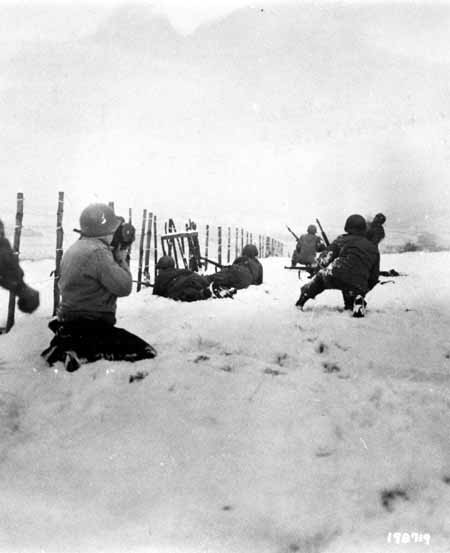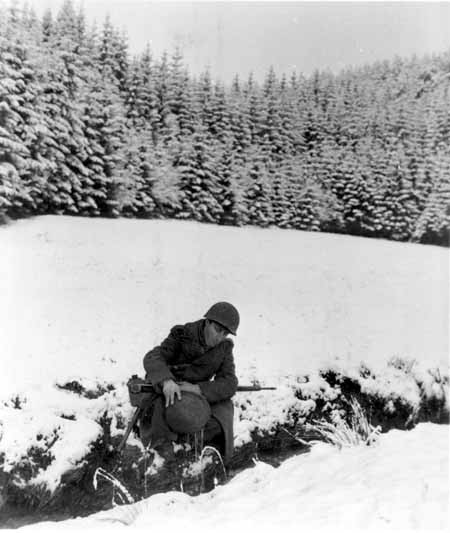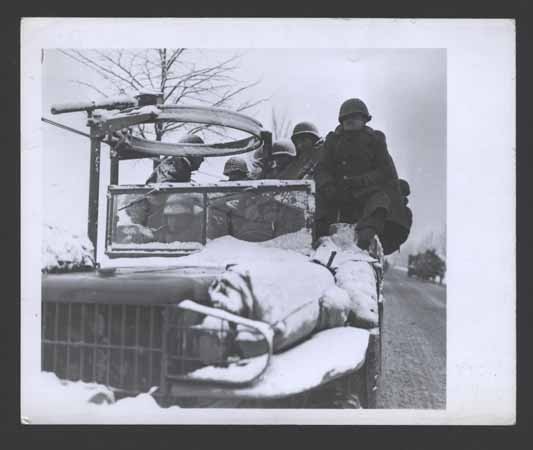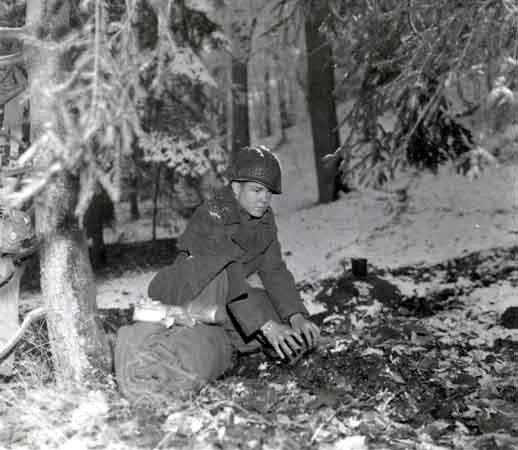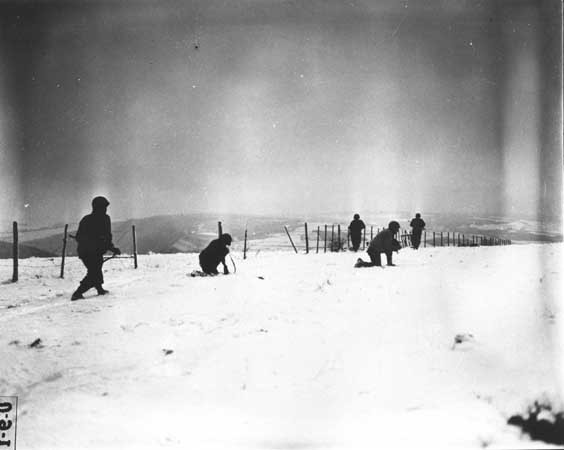
Battle of the Bulge
The Battle of the Bulge began on December 16, 1944, and lasted until the end of January 1945. It was the German military’s last-ditch, surprise counteroffensive against Allied armies in western Europe. Their effort ultimately failed. It cost Nazi Germany tremendous losses in men and military equipment.
Key Facts
-
1
The Battle of the Bulge was the last major German military offensive in western Europe. It was only temporarily successful in halting the Allied advance.
-
2
During the fighting, many captured American soldiers and Belgian civilians were murdered by Waffen-SS units. One of the best known of these atrocities is the “Malmedy Massacre.”
-
3
Many American military divisions involved in the Battle of the Bulge later took part in the liberation of prisoners from Nazi camps.
On December 16, 1944, the German military launched a last-ditch counteroffensive against the Allied armies in western Europe. Adolf Hitler hoped that the German counterattack would surround the British and American armies and roll back the Allied invasion of Germany. Yet by early January 1945, the German military effort had failed. The attack cost Nazi Germany between 80,000 and 100,000 casualties. It also resulted in enormous losses of military equipment.
The German code name for this counteroffensive was Unternehmen “Wacht am Rhein” (Operation “Watch on the Rhine,” named after a traditional, German patriotic song). The name was later changed to Unternehmen Herbstnebel (Operation “Autumn Mist”). The Allies officially called it the “Ardennes Counteroffensive.” Today, this military event is commonly referred to in English as the Battle of the Bulge. The phrase was adopted because German forces initially created a “dent” or “bulge” in Allied positions.
What Started the Battle of the Bulge?
In late 1944, the Allies attempted to penetrate across the western border of Germany. The Germans tried one last gambit to reverse their fortunes. Operation “Watch on the Rhine” (in other words, the Battle of the Bulge) was intended to split and smash British, Canadian, and US forces in the Ardennes region of western Europe. The Ardennes region was a heavily forested border area between western Germany, southern Belgium, northeastern France, and Luxembourg.
Hitler’s expectations for the operation were much greater than those of his commanders. He hoped that the German military would reach and cross the Meuse River in just a few days and quickly retake the Belgian port city of Antwerp. As a port city, Antwerp was crucial for the Allied war effort. The Nazi regime calculated that if the plan succeeded, they would be able to make the Western forces negotiate peace. A victory would also allow the German military to shift their forces to the eastern front and confront the Soviet Red Army.
What Happened During the Battle of the Bulge?
Early on December 16, some 30 German divisions launched an attack through the dense Ardennes Forest in eastern Belgium. With more than 1,000 tanks, they surprised and broke through part of the thinly held American lines. Although the Germans advanced as much as 50 miles in some areas, the gains won during the Ardennes Counteroffensive were short-lived. Despite taking dreadful losses, US forces managed to delay the Germans just enough to permit reinforcements to move into position. Improvements in weather also allowed for the use of air power to halt the German drive.
During the fighting, Waffen-SS units murdered at least 300 captured and disarmed American soldiers and some 100 Belgian civilians. The best known of the atrocities perpetrated by the Germans occurred on December 17, just south of Malmedy, Belgium.
By December 26, it was clear that the German advance had been halted short of its objective, the Meuse River. In some sectors, such as the vital Elsenborn Ridge, German troops failed to make significant progress at all. That same day, troops of the US 4th Armored Division relieved men of the 101st Airborne Division. They defended a vital road junction in the town of Bastogne.
How Did the Battle of the Bulge End?
In large part, the tenacious defense put up by American soldiers brought an end to the Battle of the Bulge. American troops fought in small groups in sub-zero cold and snow that stopped the German advance. This was all the more remarkable since many of the US units fighting in the Battle of the Bulge had taken heavy casualties in combat in the Hürtgen Forest in mid-September of that year.
US troops and some British troops widened the corridor to Bastogne at the end of December. They then counterattacked to eliminate the bulge that had been created by the German advance. Lieutenant General Courtney Hodges’ US First Army attacked from the north. And Lieutenant General George Patton's Third Army attacked from the south.
In the face of increasing Allied pressure, the Germans began to pull back their troops during the first week of January 1945. The 11th Armored Division (part of the Third US Army) joined forces with the 2nd Armored Division and the 84th Infantry Division of the First Army. Together, they mustered at Houffalize, Belgium, about 20 miles east northeast of St. Hubert, on January 16, 1945. The American advance continued, eliminating all German gains by the end of January 1945. Without halting, US forces challenged the German defenses of the Siegfried Line. The Siegfried Line was left undermanned after the heavy German losses during the Ardennes offensive.
Who Won the Battle of the Bulge?
The Allies won the Battle of the Bulge decisively. The Germans suffered between 80,000 and 100,000 casualties. The Americans suffered between 75,000 and 80,000 casualties.
Several American units that fought in the Battle of the Bulge later participated in the liberation of Nazi camps. These included, among others, the 99th Infantry Division, the 9th Armored Division, and the 82nd Airborne Division.
Critical Thinking Questions
After the war, did the American army pursue justice in the wake of the Malmedy Massacre?
How did this battle affect the course of the war?


